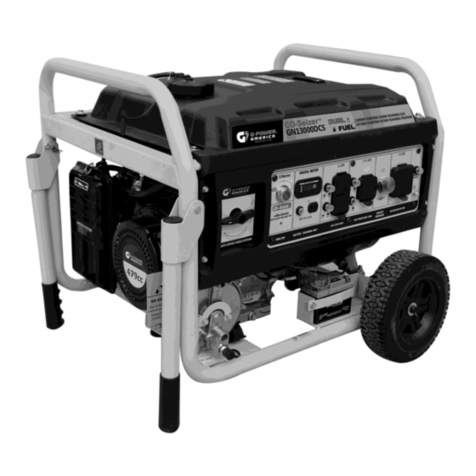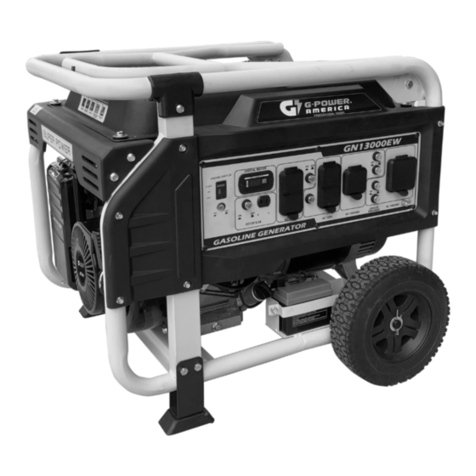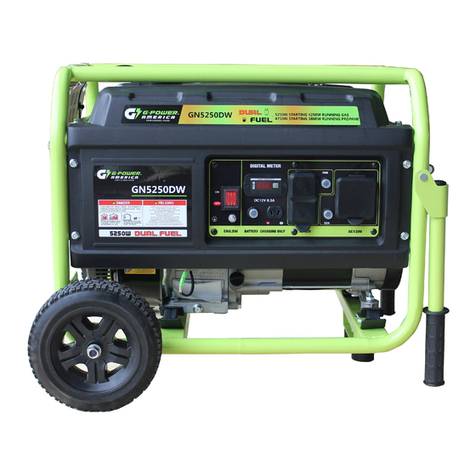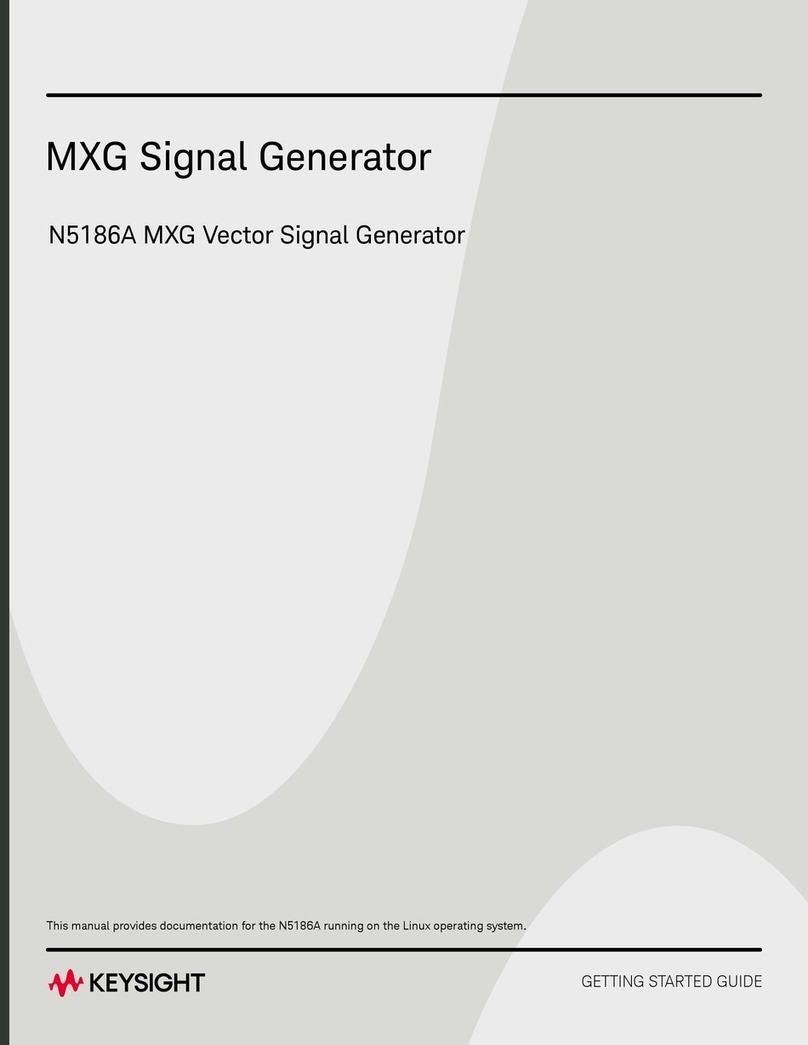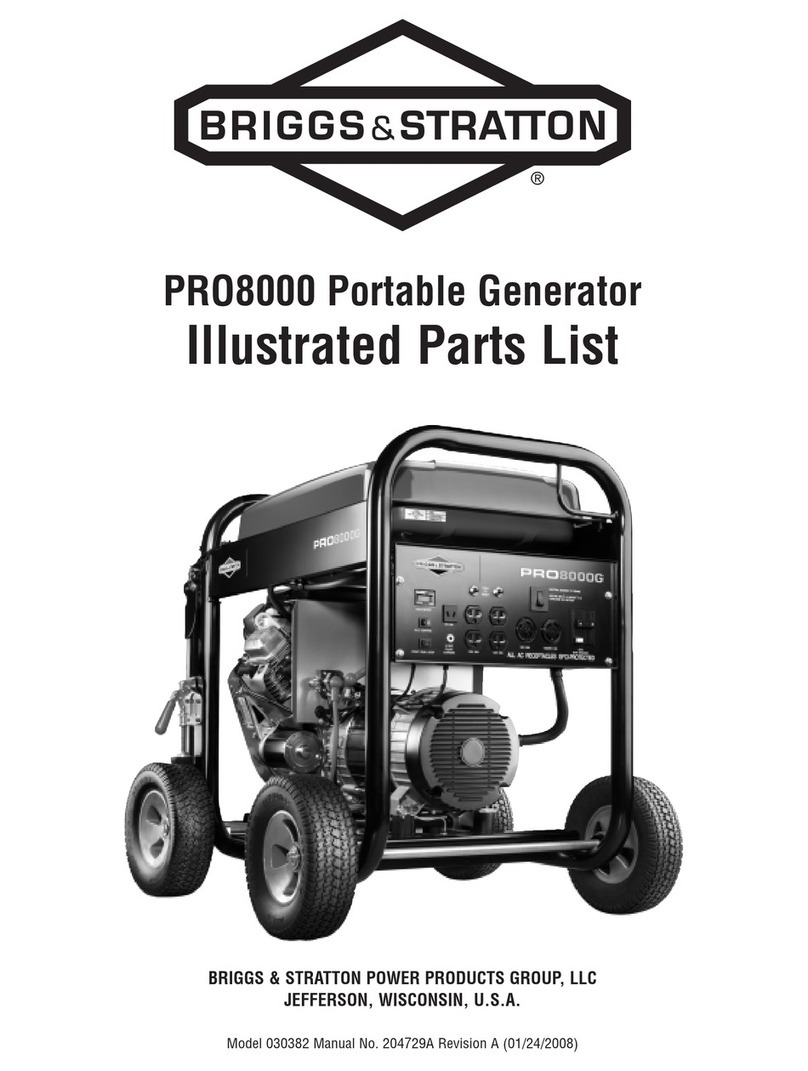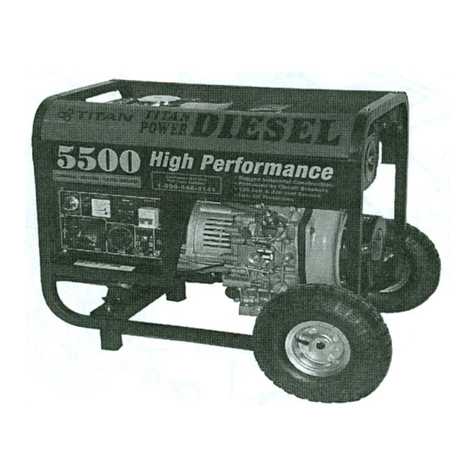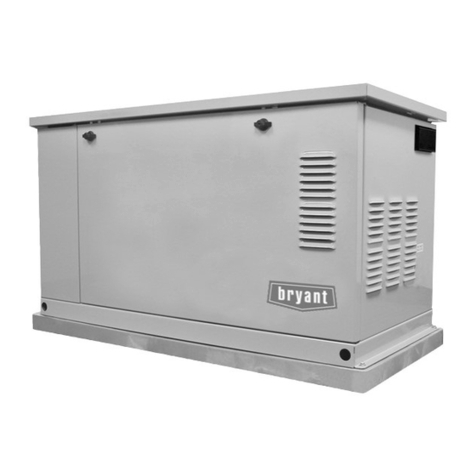G-Power America GN1750D User manual

1
We Power Your World !
Owner’s Manual for Dual-Fuel Generator
GN1750D
READ ALL INSTRUCTIONS AND WARNINGS BEFORE USING THIS PRODUCT.
This manual provides important information on proper operation & maintenance. Every effort has been made to
ensure the accuracy of this manual. These instructions are not meant to cover every possible condition and
situation that may occur. We reserve the right to change this product at any time without prior notice.
Green-Power America, LLC

2
888-834-4218
Products Service Information
Green-Power America, LLC thanks you for choosing a Green-Power America product.
Please register your product within 10 days of purchase to ensure that you receive optimal service. Keep copy of your
original receipt.
Registering your product, you are protected:
1, You have a record of the product purchase,
2, Customer Service can better serve you on Warranty related issues,
3, Green Power America will be able to contact you in the unlikely event that a product recall notification is necessary.
You can register your product in one of two ways as follows:
Option 1:
Access to the Green Power America website at www.green-poweramerica.com/service and follow the instructions to
register online following the instructions to register online.
Option 2:
Fill out the form on the Warranty Card include in the box and return via standard mail to Green Power America at 840
9th Street Suite H, Upland CA 91786. Please note that postage is required to mail the registration form back to Green-
Power America.
If you still have any questions regarding the usage or operation of your generator after you have carefully read the
manual, or if you have any quality issues during operation, please call our toll-free service number:
at, Monday-Friday, 8 AM - 5 PM ESTERN Time. A copy of the sales receipt and the product Serial number is required.
OR You may contact Green-Power through email: [email protected].
KEEP THIS MANUAL, SALES RECEIPT & APPLICABLE WARRANTY FOR
FUTURE REFERENCE.

3
TABLE OF CONTENTS
RECOGNIZE SAFETY SYMBOLS, WORDS AND LABELS .............................................................................................4
IMPORTANT SAFETY INSTRUCTIONS……………………………………………………………………………………………………….5
PACKAGE CONTENTS ....................................................................................................................................................8
PREPAREATION OF THE GENERATOR FOR USE........................................................................................................9
Using This Generator for The First Time.................................................................................................................9
Step 1 Add Oil.............................................................................................................................................9
Step 2 Add Gasoline or Propane...............................................................................................................10
Step 3 Ground the Generator....................................................................................................................10
Subsequent Use of This Generator ......................................................................................................................11
Step 1 Verify Oil Level...............................................................................................................................11
Step 2 Verify Gas Level ............................................................................................................................11
Step 3 Ground the Generator....................................................................................................................11
STARTING THE GENERATOR.......................................................................................................................................12
USING THE GENERATOR .............................................................................................................................................13
AC Usage .............................................................................................................................................................13
DC Usage .............................................................................................................................................................14
SWITCHING BETWEEN GASOLINE & PROPANE FUEL…………………………………………………………………………….14
STOPPING THE GENERATOR ......................................................................................................................................15
MAINTENANCE/CARE....................................................................................................................................................15
Recommended Maintenance Schedule ................................................................................................................15
Cleaning the Generator ........................................................................................................................................15
Checking the Oil Level..........................................................................................................................................16
Changing/Adding Oil.............................................................................................................................................16
Air Filter Maintenance...........................................................................................................................................17
Spark Plug Maintenance.......................................................................................................................................17
Emptying the Fuel Tank........................................................................................................................................17
STORAGE/TRANSPORT PROCEDURES......................................................................................................................18
TROUBLESHOOTING ....................................................................................................................................................19

4
RECOGNIZE SAFETY SYMBOLS, WORDS AND LABELS
What You Need to Know About Safety Instructions
Warning and Important Safety Instructions appearing in this manual are not meant to cover all possible conditions and situations that
may occur. Common sense, caution and care must be exercised when operating or cleaning tools and equipment.
Always contact your dealer, distributor, service agent or manufacturer about problems or conditions you do not understand.
This is the safety alert symbol. It is used to alert you to potential
personal injury hazards. Obey all safety messages that follow this
symbol to avoid possible injury or death.
DANGER indicates an imminently hazardous situation
which, if not avoided, will result in death or serious injury.
WARNING indicates a potentially hazardous situation which,
if not avoided, could result in death or serious injury.
CAUTION indicates a potentially hazardous situation which,
if not avoided, may result in minor or moderate injury.
CAUTION used without the safety alert symbol indicates a
potentially hazardous situation which, if not avoided, may
result in property damage.
ONE (1) YEAR LIMITED WARRANTY for REMAINING PARTS (30 Days Limited Warranty for Commercial and Rental Purpose)
Generators are warranted to be free from defects in materials and workmanship for a period of
ONE (1) YEAR
from date of original
purchase. Green-Power America (GPA) is not liable for any indirect, incidental or consequential damages from the sale or use of this
product. Any implied warranties are limited to
ONE (1) YEAR
as stated, or as otherwise stated, in this written limited warranty. Some
states do not allow the exclusion or limitation of incidental or consequential damages. Some states do not allow limitation on the length of
an implied warranty. will repair or replace, at its discretion, any part that is proven to be defective in materials or workmanship under
normal use during the
ONE (1) YEAR
warranty period. Warranty repairs or replacements will be made without charge for parts or labor.
Parts replaced during warranty repairs will be considered as part of the original product and will have the same warranty period as the
original product. This warranty gives you specific legal rights, and you may have other rights that vary state to state
.
TWO (2) YEARS LIMITED EMISSION for RELATED WARRANTY—1
st
Year Parts and Labor, 2
nd
Year Parts only
THIS ENGINE MEETS U.S. EPA EMISSION STANDARDS UNDER 40 CFR 1054.625.The emission-related limited warranty is valid for two (2)
years. Keep the purchase receipt and mail in the product registration card for proof of purchase. Green-Power America (GPA) limits emission-related
warranty repairs to authorized service centers for owners located within 100 miles of an authorized service center. For owners located more than 100
miles from an authorized service center, Green-Power America (GPA) will, in its sole discretion, either pay for shipping costs to and from an
authorized service center, provide for a service technician to come to the owner to make the warranty repair, or pay for the repair to be made at a
local non-authorized service center. The provisions of this paragraph apply only for the contiguous states, excluding the states with high-altitude
areas identified in 40 CFR part 1068, Appendix III.
To exercise this warranty, DO NOT RETURN TO RETAILER. Instead, call Customer Service toll free at 888-834-4218 (email address: service@green-
poweramerica.com) and you will be instructed on where to take the engine for warranty service. Take the generator and proof of purchase (your receipt)
to the repair facility recommended by the Customer Service Representative. The warranty does not extend to generators damaged or affected by fuel
contamination, accidents, neglect, misuse, unauthorized alterations, use in an application for which the product was not designed and any other
modifications or abuse.

5
Notice Regarding Emissions:
Engines certified to comply with U.S. EPA emission regulations for SORE (Small Off Road Equipment) are certified to operate on regular unleaded
gasoline and may include the following emission control systems: Three-Way Catalyst (TWC) (if equipped), and Engine Modifications (EM).
Legal Requirements:
Federal and/or State Occupational Safety and Health Administration (OSHA) regulations, local codes, and/or ordinances may apply to the intended
use of this generator. Consult a qualified electrician, electrical inspector, and/or the local agency having jurisdiction. Some areas require generators
to be registered with local utility companies. Additional regulations may apply if this generator will be used at a construction site.
IMPORTANT SAFETY INSTRUCTIONS
STOP!
Before using this generator and if you have any questions regarding the hazard and safety notices listed in this manual and/or on this
generator, call 1-888-834-4218 Monday - Friday, 8 AM - 5 PM Eastern Time.
WARNING: Do not connect this generator to a home or office electrical system. Connecting a generator to your electric utility
to another power source could damage your generator and your appliances and could cause serious injury or
even death to you or a utility worker who may be working on nearby power lines. Plug your appliances directly into the generator, do not
plug the generator into any electric outlet in your home. Doing so could create a connection to the utility company power lines. You are
WARNING:
Do not use this generator to provide power for emergency medical equipment or life support devices
.
Carbon Monoxide Gas: When in operation, the exhaust from this generator contains poisonous carbon monoxide gas. Carbon monoxide
gas is both odorless and colorless AND may be present even if you do not see or smell gas. Breathing this poison gas can lead to
headaches, dizziness, drowsiness, loss of consciousness and eventually death.
Usage: This generator is not intended to power sensitive electronic equipment such as TVs, DVD players, stereos, desktop computers or
laptop computers without the use of an appropriate line conditioner and/or surge protector (both not included).
Sensitive electronic
equipment should be operated on approved inverter type generators or pure sine wave generators. For additional information consult the devices
operation manual or call customer service at Monday - Friday, 8 AM - 4 PM Central Time.
Usage: Avoid the use of extension cords if possible.
If you choose to use them, be sure they are sized adequately to handle the flow of
electricity. An undersized cord can overheat, short out and cause a fire.
Propane(LPG): This generator may emit highly flammable and explosive vapors, which can cause severe burns or even death. A nearby
open flame can lead to an explosion even if not directly in contact the fuel.
·
Don’t operate this generator near open flame.
·
Always operate this generator on a firm, level surface.
The fuel is highly flammable and explosive. Handling fuel can result in serious injury or burns.
·
Before starting the generator, inspect your LPG tank valve for damage or leaks, attach only approved tanks that have been properly filled by an
Approved station. DO NOT light or smoke cigarettes.
·
Replace the hose at the first sign of a leak or if age-cracking becomes apparent.
·
Always handle propane fuel and generator outdoors.
·
Before transporting, turn the fuel valve to the “off “position and disconnect the spark plug.
WARNING:
USE THIS GENERATOR ONLY OUTDOORS IN NON-CONFINED AREAS
.
DO NOT SECURE THE GENERATOR WITH A CHAIN
OR ROPE. AS THIS WILL MAKE IT DIFFICULT TO MOVE IN AN EMERGENCY.
·
Keep at least several feet of clearance on all sides to allow proper ventilation for this generator.

6
Powerful Voltage: This generator produces powerful voltage, which can result in electrocution.
uilding electrical
system to this generator without a qualified electrician.
Doing so voids your warranty.
Such connections must isolate generator power from utility
power and comply with local electrical laws and codes. Failure to comply can create a back feed into utility lines creating an electrocution hazard,
which may result in serious injury or death to utility workers. Such a back feed may cause this generator to explode, burn and create fires when
utility power is restored.
areas such as metal decking or steel work. GFCIs are available in-line with some
extension cords.
Keep generator dry and operate with dry hands. Do not use this generator in wet conditions (rain, snow, active sprinkler system, wet hands, etc.).
t touch bare wires or outlets (receptacles).
-qualified persons to operate this generator.
Flammable Gasoline: This generator may emit highly flammable and explosive gasoline vapors, which can cause severe burns or even
death. A nearby open flame can lead to an explosion even if not directly in contact with gasoline.
is generator.
Gasoline is highly flammable and explosive. Handling fuel can result in serious injury or burns.
-ventilated area. Keep heat, sparks and flame away while refueling and away
from the location where gasoline is stored. Never refuel indoors where gasoline fumes may reach flames and/or sparks.
ank cap. Loosen the cap slowly to relieve pressure in the fuel tank.
Avoid spilling fuel.
ank.
and immediately wipe it up before starting this generator.
High Temperatures: This generator produces heat when in operation. Temperatures near the exhaust can exceed 150 Degrees
Fahrenheit (65 Degrees Celsius).
h hot surfaces. Observe all warning placards on this generator denoting hot surfaces.
during operation and
before storing indoors.
ny structure.
Usage: Consult a physician(s) before using this generator if using a pacemaker.
Electromagnetic fields in close proximity to a heart
pacemaker could cause a pacemaker to malfunction or fail. C
Usage: Prolonged exposure to high noise levels can be hazardous to hearing.
Always wear ANSI-approved hearing protection when
operating or working around the generator when it is running.
Usage: Misuse of this generator can damage it or shorten its life.
Use this generator only for its intended purpose.
·
Operate this generator only on a dry, level surface. Do not secure the generator with a chain or rope, which would prevent
it from being moved
in an emergency.
·
Allow this generator to run for several minutes before connecting any electrical devices.
·
Promptly turn off any malfunctioning devices and disconnect them.
·
Do not operate an excessive number of electrical devices in excess of the wattage capacity of this generator.
·
Do not turn on electrical devices until after they are connected to this generator.
·
Turn off all connected electrical devices before stopping this generator.

7
In addition to the previously described safety information, familiarize yourself with all safety and hazard placards on this generator.

8
PACKAGE CONTENTS
The following items are supplied with this Generator. Verify that all items are included.
STOP!
If there are missing items, call 1-888-834-4218
, Monday - Friday, 8 AM - 5 PM EASTERN Time
for customer service.
DO NOT RETURN
THIS GENERATOR TO THE RETAILER.
Item List:
DC connector wires for charging 12 Volt automotive-type batteries
Spark plug wrench
5 Ft. Regulator Hose Kit
(YOU MUST USE THE SUPPLIED REGULATOR FOR SAFE OPERATION)

9
PREPARATION OF THE GENERATOR FOR USE
Using this Generator for the First-Time
STOP!
The following section describes the required steps for preparing this generator for the first use. Failure to correctly perform
these steps can damage this generator and/or shorten its life. If still unsure about how to perform any of these steps after
reading this section, call 1-888-834-4218 Monday - Friday, 8 AM - 5 PM EST for customer service.
If this generator is being used for the first time, the following few steps are required to prepare for operation:
Step 1 - Add Oil
THIS GENERATOR REQUIRES AT LEAST 13.5 FL OZ OF OIL (SAE10W-30) TO RUN.
ADD OIL UNTIL IT IS ALMOST OVERFLOWING. THE LOW-OIL SENSOR IS VERY SENSITIVE AND THE ENGINE WILL NOT
RUN IF THE OIL IS LOW. START WITH 13.5 OUNCES, THEN ADD MORE UNTIL ALMOSTOVERFLOWING.
TROUBLESHOOTING: IF THE GENERATOR WILL NOT START, DOUBLE CHECK THAT THE OIL LEVEL IS
COMPLETELY FULL AND ALMOST OVERFLOWING.
This generator requires engine oil to function. Engine oil is a major factor affecting engine performance and service life.
When new from the package, this generator contains no oil in the engine crankcase. Add oil before operating this generator for the first
time. When replenishing oil for subsequent use of this generator, always determine that this generator has the correct quantity of oil.
To add oil to the engine crankcase:
1.
Confirm that this generator is on a level surface.
2.
Unscrew the oil filler/dipstick cap from the engine as illustrated in Figure 1 below.
3.
Using a funnel, add high detergent motor oil to fill the engine crankcase to the correct quantity. SAE10W-30 oil is recommended for
general use. When the engine crankcase is full and almost overflowing, the oil level should reach the lower lip of the oil filling opening
as shown in Figure 2.
4.
Replace the oil filler/dipstick cap and close the oil access panel.
Figure 1 Unscrew the Dipstick Cap Figure 2 - Add Oil

10
Step 2 - Add Gasoline or Connect Propane Tank
To add gasoline:
To ensure that this generator runs smoothly, use only FRESH, UNLEADED GASOLINE WITH AN OCTANE RATING OF 87 OR HIGHER. Unleaded
gasoline produces fewer engine and spark plug deposits and extends the life of the exhaust system.
1.
Be sure that the generator is on a level surface.
2.
Unscrew fuel tank cap and set aside. (NOTE: The fuel tank cap may be tight and difficult to unscrew.)
3.
Slowly add fresh, unleaded gasoline (with an octane rating 87 or higher) to the fuel tank. Be careful not to fill the fuel tank above the upper limit
line.
NOTE
: Because gasoline can expand, do not fill the fuel tank to the very top.
4.
Securely tighten the fuel tank cap and immediately wipe up any spilled gasoline with a dry cloth.
Fuel Tank Capacity (gallons)
1.2
Fuel Type
Fresh, Unleaded Gasoline Octane Rating 87 or Higher
IMPORTANT:
•Use UNLEADED gasoline with an octane rating 87 or higher.
•NEVER use a mixture of oil and gasoline.
•NEVER use old and /or contaminated gasoline.
•Avoid getting dirt and /or water in the fuel tank.
•Gasoline can get aged and oxidative deterioration in the fuel tank , which makes generator starting difficult. Never store the generator
with fuel for extended time (over one month).
To connect propane:
If using LPG / Propane, first connect the regulator , which was included with the generator, to the Propane Tank, then connect the other end to the
Gas Inlet. Make sure the LPG/Propane cylinder is vertical and securely positioned.
Step 3 - Ground the Generator
Ground this generator by tightening the grounding nut against a grounding wire as illustrated in Figure 3. Use a No. 12 AWG (American Wire Gauge)
stranded copper wire which is generally considered an acceptable grounding wire. The other end of this grounding wire should be connected to a
copper or brass grounding rod that is driven into the earth. Proper grounding
of the generator will help prevent electrical shock in the event of a ground fault
condition in the generator or in connected electrical devices.
Proper grounding also helps dissipate static electricity, which often builds
up in ungrounded devices.
Grounding codes can vary by location. Contact a local electrician
for information on grounding regulations for your area.
Failure to properly ground this generator can result in electrocution.
Figure 3
The Grounding Terminal
is located on the front of
the generator, to the
right of the AC Output
socket.
Gasoline and gasoline fumes are highly flammable and explosive. Handling fuel can result in serious injury or burns.
·
Do not fill the fuel tank near a heat, sparks or an open flame. Keep gasoline away from appliance pilot lights, barbecues, electrical appliances,
power tools, etc.
·
Do not overfill the fuel tank. Always check for fuel spills and immediately wipe them up. Spilled fuel is a fire hazard and causes environmental
damage.

11
Subsequent Use of this Generator
For subsequent uses of this generator after the first use, certain steps still must be completed to prepare it for operation.
manual. If not, review this section now.
Step 1 - Verify Oil Level
It is important to check the oil level in the engine crankcase
BEFORE EACH USE
to ensure the OIL is sufficient.
1.
Verify that this generator is on a level surface.
2.
Unscrew the oil filler/dipstick cap from the engine.
3.
With a dry cloth, wipe the oil off of the dipstick that is located on the inside of the cap.
4.
Fully insert the dipstick without screwing the filler/dipstick cap and then remove again. There should be oil on the dipstick. If there is no oil on the
f this manual).
5.
Confirm that the oil filler/dipstick cap is properly screwed in place when finished verifying the oil level.
Step 2 - Verify Gas Level If Using Gasoline Fuel
Before starting this generator, verify that there is sufficient gasoline in the fuel tank. If necessary, add fresh unleaded gasoline with an octane rating
-
Fuel Tank Capacity (gallons)
1.2
Fuel Type
Fresh, Unleaded Gasoline Octane Rating 87 or Higher
IMPORTANT:
·
Use only fresh UNLEADED gasoline with an octane rating of 87 or higher.
·
Never use old and /or contaminated gasoline.
·
Never use a mixture of oil and gasoline.
·
Avoid getting dirt and/or water in the fuel tank.
·
Never store generator for extended time with gasoline in the fuel tank.
Step 3 - Ground the Generator
Ground this generator by tightening the grounding nut against a grounding wire as previously illustrated in Figure 3. An acceptable grounding wire is
a No. 12 AWG (American Wire Gauge) stranded copper wire. The other end of this grounding wire should be connected to a copper or brass
grounding rod that is driven into the earth.
Grounding codes can vary by location. Contact a local electrician for information on grounding regulations for your area.
Failure to properly ground this generator can result in electrocution.
Gasoline and gasoline fumes are highly flammable and explosive. Handling fuel can result in serious injury or burns.
·
Do not fill the fuel tank near a heat, sparks or an open flame. Keep gasoline away from appliance pilot lights, barbecues, electric appliances, power
tools, etc.
·
Always
allow several minutes for the engine to cool before refueling.
·
Do not overfill the fuel tank. Always check for fuel spills and immediately wipe them up. Spilled fuel is a fire hazard and causes
environmental damage.

12
STARTING THE GENERATOR
STOP!
Before starting this generator, make sure that all the
steps in the section titled “ Preparing the Generator for Use “ of this manual
have been read and understood correctly.
To start this generator:
1. Confirm that there are no electrical devices connected to this generator. Connected devices may increase the difficulty in starting the engine.
3A. If using gasoline, t position and disconnect the LPG/Propane hose.
3B. If using propane, turn the LPG/Propane tank valve to “ON” position and
BE SURE TO TURN THE FUEL VALVE TO “OFF” POSITION
.
6.
Slowly pull on the recoil starter handle, shown in Figure 4, until a slight resistance is felt. Then pull briskly to start the engine. Gently return the
cord into the generator to avoid damage to the starter or housing. Never allow the cord to snap back.
7.
If the engine fails to start, repeat step 6
. NOTE
: After repeated attempts to start the engine, consult the troubleshooting guide before attempting
again.
8.
Once the engine has started, GRADUALLY move the choke lever to the “OPEN/RUN”position until the engine levels off.
Then let the engine run approximately 5 minutes BEFORE connecting appliances or tools.
Fuel Cock
The fuel cock is located between the fuel tank and carburetor. When the fuel cock is in the ON position, fuel is allowed to flow from the fuel tank to
the carburetor. Be sure to return the fuel cock to the OFF position after stopping the engine.
Choke Rod
The choke is used to provide an enriched fuel mixture when starting a cold engine. It can be opened and closed by operating the choke rod
manually. Pull the rod out toward CLOSED to enrich the mixture for cold starting
Disconnect all electrical loads from this generator before attempting to start.
Figure 4
The Recoil Start is located on the left
side of the generator.

13
USING THE GENERATOR
-CONFINED AREAS. DO NOT SECURE THE GENERATOR WITH A CHAIN OR ROPE, AS
THIS WILL MAKE IT DIFFICULT TO MOVE IN AN EMERGENCY.
·
Keep at least several feet of clearance on all sides to allow proper ventilation for this generator.
·
After the engine has been running for several minutes, electrical devices may be connected to this generator.
AC Usage
Electrical devices running on AC current may be connected according to their wattage requirements.
Rated (Running) Wattage
1200 Watts Running Gas / 950 Watts Running Propane
Surge Wattage
1750 Watts Running Gas / 1200 Watts Running Propane
The rated (running) wattage corresponds to the maximum wattage a generator can output on a continuous basis.
The surge wattage corresponds to the maximum amount of power a generator can output for a short time. Many electrical devices, such as a
refrigerator, require short bursts of extra power for starting and stopping fan motors, etc., in addition to their listed rated wattage. Motorized devices
typically require more than their rated wattage for startup. The surge wattage ability of a generator allows for this extra power requirement.
The total running wattage requirement of the electrical devices connected to a generator should not exceed the rated wattage of the generator itself.
To calculate the total wattage requirement of the electrical devices to be connected, look up the rated (running) wattage of each device and add
these numbers together to find the total wattage that all of the devices together will draw from the generator. If the total wattage of the selected
devices exceeds the rated wattage of the generator, DO NOT connect all of the devices. Select a combination of the electrical devices that will have
a total wattage less than or equal to the rated wattage for the generator.
A device's rated (running) wattage should be listed somewhere on the device itself and/or in its manual. If the wattage spe cification for a device is not
available, the wattage can be calculated by multiplying the Voltage requirement (120) by the Amperage drawn.
Watts = Volts x Amperes
Or, the wattage required by a device can be estimated by using the following chart. The chart provides only estimates and it is better to know the
exact wattage of each electrical device to be powered by this generator.
NOTE:
Plug appliances into the correct outlet. Connect
standard 120 Volt, single phase, 60 Hz loads to the 120
Volt outlet. Connect 12 Volt, DC loads to the 12 Volt
outlet.
This generator can run at its surge wattage capacity for only a short time. Connect electrical devices requiring a rated (running) wattage
equal to or less than the rated wattage of this generator. Never connect devices requiring a rated wattage equal to the surge wattage of a
generator.
Connect only electrical devices that are in good
working order. Faulty devices or power cords
present the risk of electrical shock. Immediately
turn off and disconnect any device that
commences to operate abnormally, sluggish or
abruptly stops. Determine if the problem was the
device or the rated load capacity of this generator
has been exceeded.
Electrical Device
Rated (Running) Watts
Additional Surge Watts
air compressor (1 - 1/2 HP)
2500
2500
airless sprayer (1/3 HP)
600
1200
coffee maker
1500
0
computer w/17 inch monitor
800
0
deep freezer
500
500
electric drill (1/2 HP)
1000
1000
furnace fan blower (1/2 HP)
800
1300
hot plate
2500
0
microwave oven (1000 watt)
1000
0
quartz halogen work light
1000
0
refrigerator/freezer (18 Cu. Ft.)
800
1600
saw - circular (7 1/4 inch)
1500
1500
stereo receiver
450
0
electric stove - single element
1500
0
sump pump
800
1200
television (27 inch color)
500
0
well water pump (1/3 HP)
1000
2000
window air conditioner (10000 BTU)
1200
2000
window fan
300
600

14
NOTE:
While this generator is running, power is available from either the standard 120 Volt outlet or the 12 Volt DC outlet. Both 120 Volts and 12
Volts can be simultaneously drawn from this generator.
Turn on the connected electrical devices beginning with the device with the highest rated wattage requirement and then each additional device with
the next lower rated wattage requirement.
DC Usage
To Plug Items to the Generator
1.
Allow the engine to run for several minutes after starting.
2.
Make sure that the electrical device is switched off prior to plugging it to generator.
4. Turn on the connected electrical devices beginning with the device with the highest rated wattage requirement and then each additional device
with the next lower rated wattage requirement.
SOME NOTES ABOUT POWER CORDS
Long or thin cords require more wattage from a generator to power an electrical device. Figure 6 shows the recommended cords according to the
power requirement of the electrical device. When using cords that exceed these specifications, allow for the electrical device to have a slightly
higher rated wattage requirement.
Device Requirements
Max. Cord Length (ft) by Wire Gauge
Amps
Watts (120V)
Watts (240V)
#8 wire
#10 wire
#12 wire
#14 wire
#16 wire
2.5
300
600
NR
1000
600
375
250
5
600
1200
NR
500
300
200
125
7.5
900
1800
NR
350
200
125
100
10
1200
2400
NR
250
150
100
50
15
1800
3600
NR
150
100
65
NR
20
2400
4800
175
125
75
50
NR
25
3000
6000
150
100
60
NR
NR
30
3600
7200
125
65
NR
NR
NR
40
4800
9600
90
NR
NR
NR
NR
Figure 6 - Maximum Extension Cord Lengths by Power Requirement
SWITCHING BETWEEN GASOLINE & PROPANE FUEL
In order to switch between gasoline and propane fuel, you must turn off the current fuel. For example, if using gasoline and you want to switch to
propane, turn the gasoline Fuel Petcock to OFF position and let the engine continue to run until it burns off all remaining gasoline fuel in carburetor.
Then turn the propane tank ON. If using propane and you want to switch to gasoline, turn the propane tank OFF and turn the gas Fuel Petcock ON.
Even though this generator has an overall rated wattage of 1350, do not attempt to draw more than 1100 Watts from the 120 Volt outlet.
Draws higher than 1100 Watts will damage this generator and void the warranty.
Do not connect 50Hz or 3-phase loads to this generator.
The DC outlet is for charging 12 Volt battery, up to 8 Amps.
NEVER attempt to jumpstart a car with this generator.
Do not secure the generator with a chain or rope, which would prevent it from being moved in an emergency.

15
STOPPING THE GENERATOR
To stop generator:
1.
Turn off all connected electrical devices and then unplug them.
2.
Allow this generator to run for several more minutes with no electrical devices connected to help stabilize the temperature of this generator.
3.
If using gasoline, turn the fuel valve to the “OFF”position.
4.
Set the engine power switch to the “OFF”position.
5.
If using propane, turn the propane tank fuel valve to the “OFF”position., then turn off the engine power switch.
MAINTENANCE/CARE
Proper routine maintenance of this generator is essential for safe, economical, and trouble-free operation. It will help prolong the life of this generator
as well as help reduce air pollution. Perform maintenance checks and procedures according to the schedule in Figure 7.
Recommended Maintenance Schedule
Each Use
Every Month or
Each 20 Hrs
Every 3 Months or
Each 50 Hrs
Every 6 Months or
Each 100 Hrs
Every Year or
Each 300 Hrs
Engine Oil
Check Level
X
Replace
X (first use)
X
Air Filter
Check
X
Clean
X
Spark Plug
Check/Clean
X
Fuel Tank
Verify Gas Level
X
Clean
X
Figure 7 - Recommended maintenance schedule
Cleaning Generator
Always try to use this generator in a cool dry place. If this generator becomes dirty, the exterior can be cleaned with a damp cloth, soft brush,
vacuum and/or pressurized air.
Never clean this generator with a bucket of water and/or a hose as water can get inside and cause a short circuit or corrosion.
Never use gasoline to clean parts of this generator.
Allow this generator to cool down before touching areas that become hot during operation.
Allowing gasoline to sit in this generator's fuel tank for extended time without use can increase the difficulty in starting this generator in
the future. Never store this generator for extended time with gasoline in the fuel tank.
Never perform maintenance procedures while this generator is running. Allow this generator to cool before commencing any maintenance
procedures. Keep heat, sparks and flame away.
Improper maintenance and/or failure to correct any problems prior to operating this generator can cause a malfunction which could cause
death or serious injury. Always follow the inspection and maintenance recommendations and schedules in this manual.

16
Checking the Oil Level
It is important to check the oil level in the engine crankcase before each use to ensure that it’s sufficient.
To check the oil level:
1.
Verify that this generator is shut down and on a level surface.
2.
Unscrew the oil filler/dipstick cap from the engine.
3.
Clean the dipstick with a dry cloth.
4.
Insert the dipstick screwing down and then take out again. If there is no oil on the dipstick, or oil is visible only at the very end of the
dipstick, add oil until the oil level up to the middle or up of the dipstick position.
5.
Make sure that the oil dipstick cap is properly screwed when finished checking the oil level.
Changing/Adding Oil
The oil level in this generator should be checked before each use. (See Figure 8.) When the oil level is low, add oil until the oil level is between
the lower mark and upper mark.
The oil should be changed after the first 20 hours of operation. Subsequently, the oil should be changed every 6 months, or for every 100 hours of
use, or when the oil has become dirty.
To drain the oil from generator:
1.
Place a bucket underneath this generator to catch oil as it drains.
2.
Unscrew the oil drain plug located on the crankcase underneath the oil filler/dipstick cap using 10 mm hex wrench. Figure 8A.
3.
Allow all oil to drain out from generator.
4.
Replace the oil drain plug and tighten. Figure 8A.
NOTE: Put oil in a sealed container and contact your local recycling center or auto garage
to arrange oil disposal.
THIS GENERATOR REQUIRES AT LEAST 13.5 FL OZ SAE10W-30 or UP
GRADE TO RUN. Oil type may change according to the ambient
temperature. See the chart shown left.
ADD OIL UNTIL IT IS ALMOST OVERFLOWING. THE LOW-OIL SENSOR IS
VERY SENSITIVE AND THE ENGINE WILL NOT RUN IF THE OIL IS LOW.
START WITH 13.5 FL OZ THEN ADD MORE UNTIL ALMOST
OVERFLOWING.
TROUBLESHOOTING: IF THE GENERATOR CAN NOT START, DOUBLE CHECK to MAKE SURE THE OIL
IS SUFFICIENT.
Figure 8 Adding oil
Add until it is
almost overflowing
Figure 8A Changing oil
32
°F
°F
80
25
°C
°C
0
or 10W-30
SAE #30
or 1
5
W-40
SAE #20
or 10W-30
or 1
5
W-40
or 1
5
W-40
or 10W-30
SAE 10W

17
Air Filter Maintenance
Routine maintenance of the air filter helps maintain proper airflow to the carburetor. Occasionally verify that the air filter is free of excessive dirt. The
air filter will require more frequent cleaning when the generator is operating in extremely dusty areas.
To clean the air filter, remove the foam filter element from the generator and wash it in warm water and household dish detergent. Thoroughly rinse
and dry. Pour a little amount of motor oil onto the filter, ring out ALL excess oil, and reinstall the foam filter element in the generator.
Unscrew the bolts, or unsnap the clips at the top and bottom of the air filter cover, located below the choke lever, to access the foam filter element.
Spark Plug Maintenance
The spark plug is essential for proper engine operation. The spark plug should be intact, free of deposits, and properly gapped. A bad or incorrectly
installed spark plug can cause engine damage. To inspect the spark plug:
1.
Remove the spark plug by pulling on the spark plug cap.
2.
Unscrew the spark plug from the generator by using the spark plug wrench.
3.
Visually inspect the spark plug. If it is cracked and/or chipped, replace with a new spark plug. An E7TC spark plug, such as
NGK
BP6HS
, is recommended.
4.
Measure the spark plug electrode gap with a gauge. The gap should be 0.020-0.028in (0.5-0.7mm). (See Figure 9.)
5.
If re-using the spark plug, use a wire brush to clean any dirt from around the spark plug base and then re-gap the spark plug.
6.
Screw the spark plug back into place on the generator.
7.
Replace the spark plug cap.
Figure 9 Measuring the spark plug gap
To store this generator for extended time, drain gasoline out from the carburetor AND fuel tank.
To drain gasoline from the generator:
1. Turn the fuel valve to the “OFF”position and let the engine run until it stops.
2.
Remove the fuel filter cup.
3.
Empty the fuel filter cup of any fuel.
4.
Place a container underneath this generator to catch gasoline as it drains.
5.
Turn the fuel valve to the “ON”position and allow all gasoline to drain out.
6.
Turn the fuel valve to the “OFF”position.
7.
Replace the fuel filter cup.
8.
Store the drained gasoline in a suitable place.
To store this generator for extended time, the fuel needs to be drained out from the carburetor completely.
To drain the gasoline from the carburetor, turn the fuel valve to the “OFF”position while the engine is running. The generator will shut down when
all the gasoline in the carburetor has been used up, OR, unscrew the draining bolt on the bottom side of the carburetor to drain all gasoline out
completely.

18
STORAGE/TRANSPORT PROCEDURES
When transporting or storing this generator for extended time:
Storage Time
Recommended Storage Procedure
(which will help prevent difficult starts)
Less than 1 month
No storage procedure required.
1 to 2 months
Fill with fresh gasoline and add gasoline stablizer
2 months to 1 year
Empty the fuel tank. (See Emptying the Fuel Tank in the Maintenance/Care section.)
1 year or more
Empty the fuel tank. (See Emptying the Fuel Tank in the Maintenance/Care section.) Disconnect the spark plug.
Never place any type of storage cover on this generator while it is still hot.

19
TROUBLESHOOTING
.
Symptom
Cause
Solution
Engine will not start.
Engine switch is set to "off."
Set engine switch to "on."
Fuel valve is turned to "closed."
Turn fuel valve to "open."
Set the choke to
Engine is out of gasoline.
Add gasoline.
Engine is filled with contaminated and/or old
gasoline.
Drain gasoline from the engine and add new
gasoline.
Spark plug is dirty.
Clean spark plug.
Spark plug boot is cracked.
Replace spark plug.
Spark plug is broken.
Replace spark plug.
Oil is low.
The oil level should almost OVERFLOW. If it is
not, add more oil.
Engine will not start.
Spark plugs not sparking.
Verify that you have spark. Pull spark plug cap
off spark plug. Take spark plug out using spark
plug wrench. Put spark plug back into boot and
hold it onto bare metal. Make sure the on/off
switch is in the ON position. Pull the starter.
You should see a spark.
Engine will not start.
Engine will not start.
Engine will not start.
Engine runs but there is no electrical output.
Generator runs but does not support all
connected electrical devices.
If the engine starts and runs, but does not
produce power, or power is too low.
Carburetor is gummed up.
If the generator has been sitting for a long time,
it is possible that it is gummed up. Remove air
box cover, then remove the air filter. Remove
the two 10mm nuts that hold the carburetor. Lift
up on the throttle linkage on the top of the
carburetor. It should pop off. Pull the fuel line
off. The carburetor will slide off. Turn the
carburetor upside down and remove the 10mm
bolt on the bottom of the bowl. Remove the pin
that holds the float on. Pull the float up. Inspect
the float needle, and make sure the orifice is
not gummed up. Remove the rubber gasket,
then clean the orifice if it is dirty. Use carb
cleaner. Do not spray carb cleaner on the float
needle or any rubber.

20
Distributed by:
Green-Power America, LLC
www. Green-PowerAmerica.com
All copyright© is reserved by Green-Power America, LLC
Table of contents
Other G-Power America Portable Generator manuals
Popular Portable Generator manuals by other brands
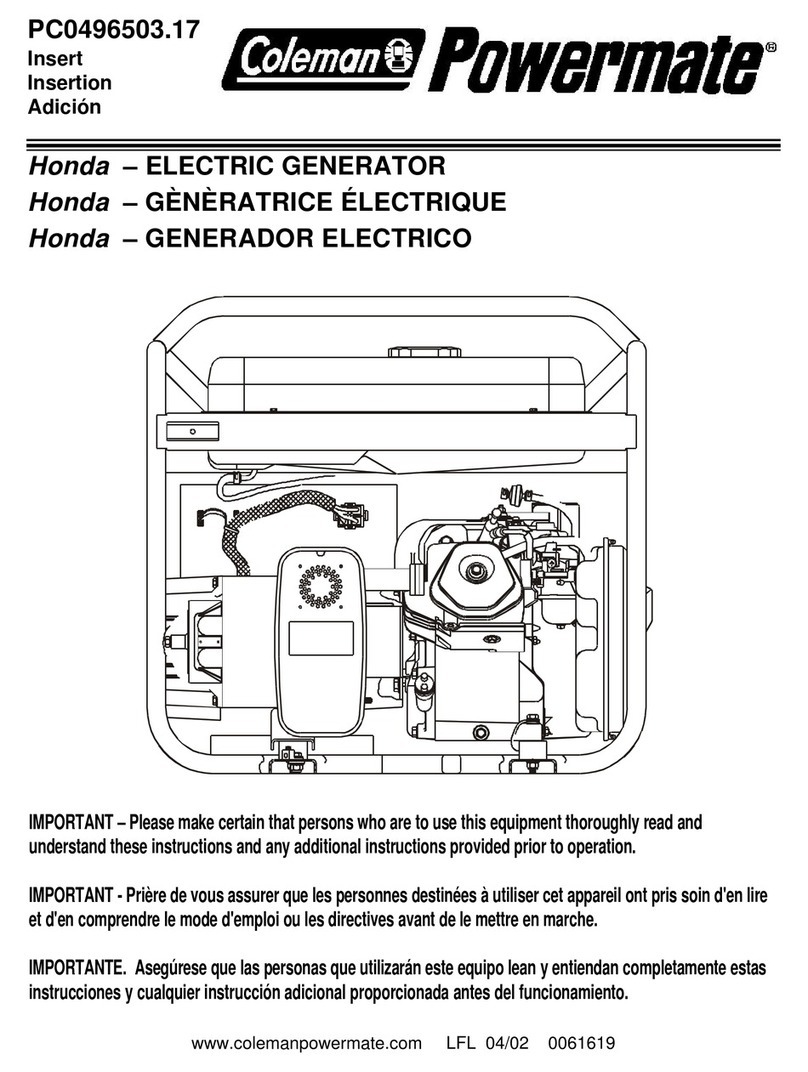
Powermate
Powermate PC0496503.17 manual
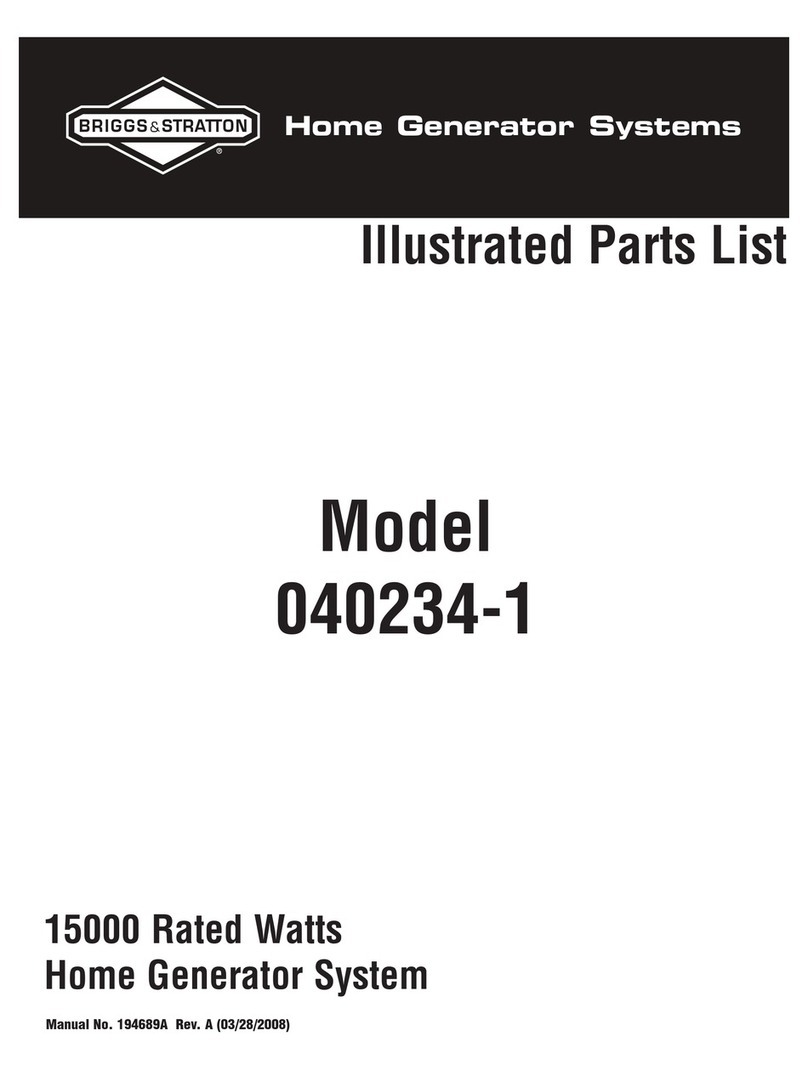
Briggs & Stratton
Briggs & Stratton 040234-1 Illustrated parts list

Hensel-Visit
Hensel-Visit Nova D 1200 user manual
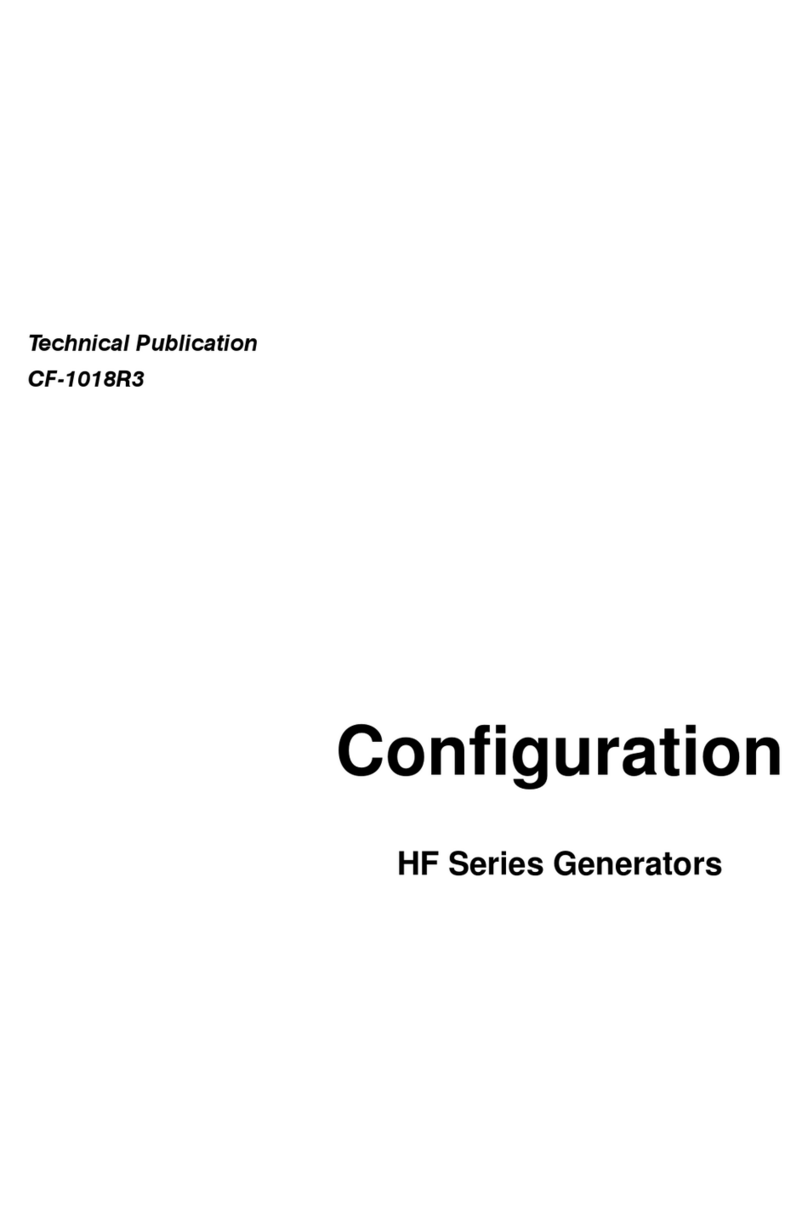
TXR
TXR HF Series Configuration
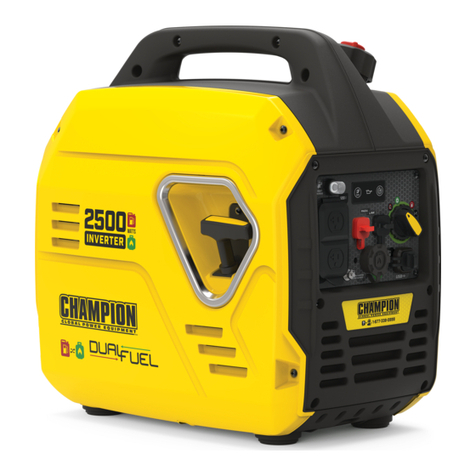
Champion Global Power Equipment
Champion Global Power Equipment 100899 Operator's manual
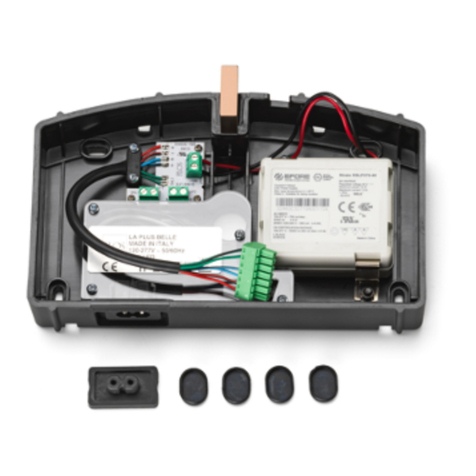
FLOS
FLOS LA PLUS BELLE F3680015 manual

Keysight Technologies
Keysight Technologies X-Series Programming guide
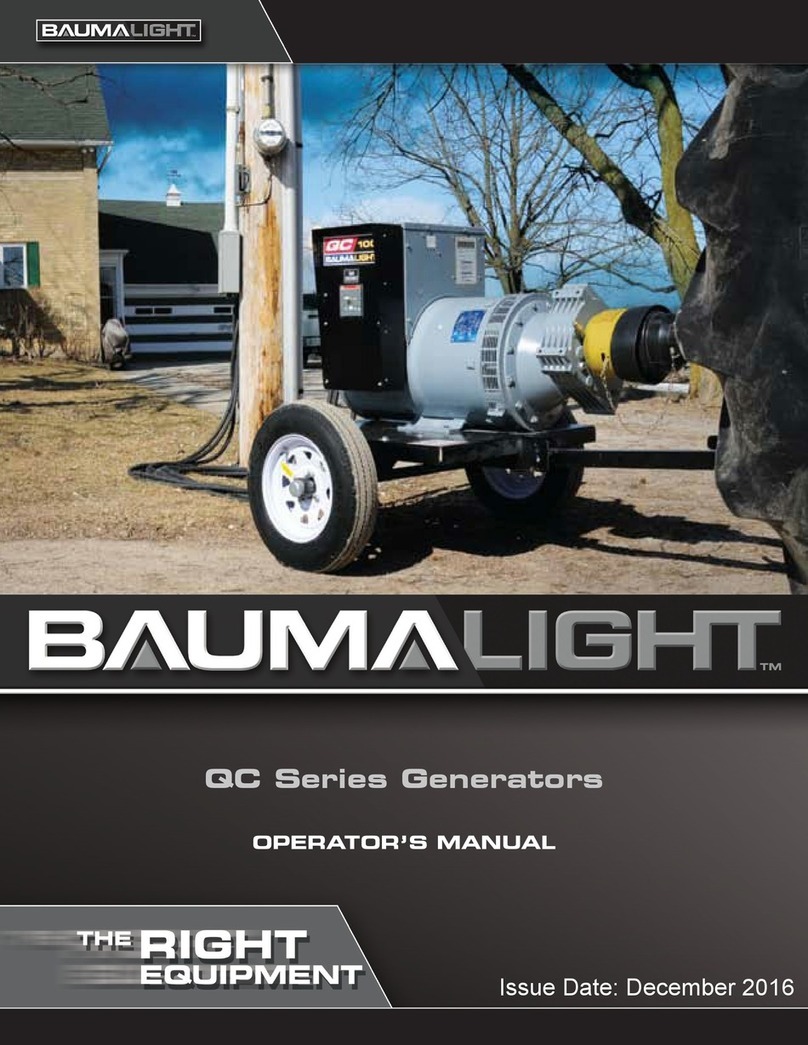
MTB
MTB Baumalight QC Series Operator's manual

Champion Power Equipment
Champion Power Equipment 100900 quick start guide
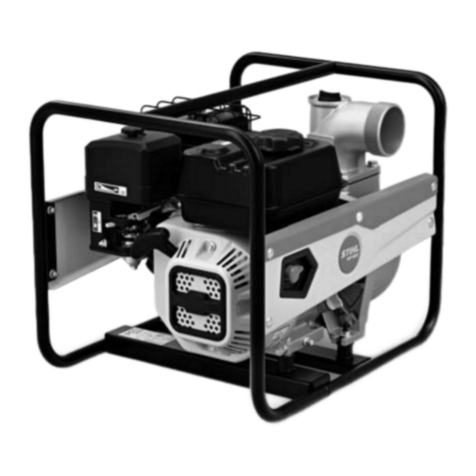
Stihl
Stihl WP 600.0 instruction manual
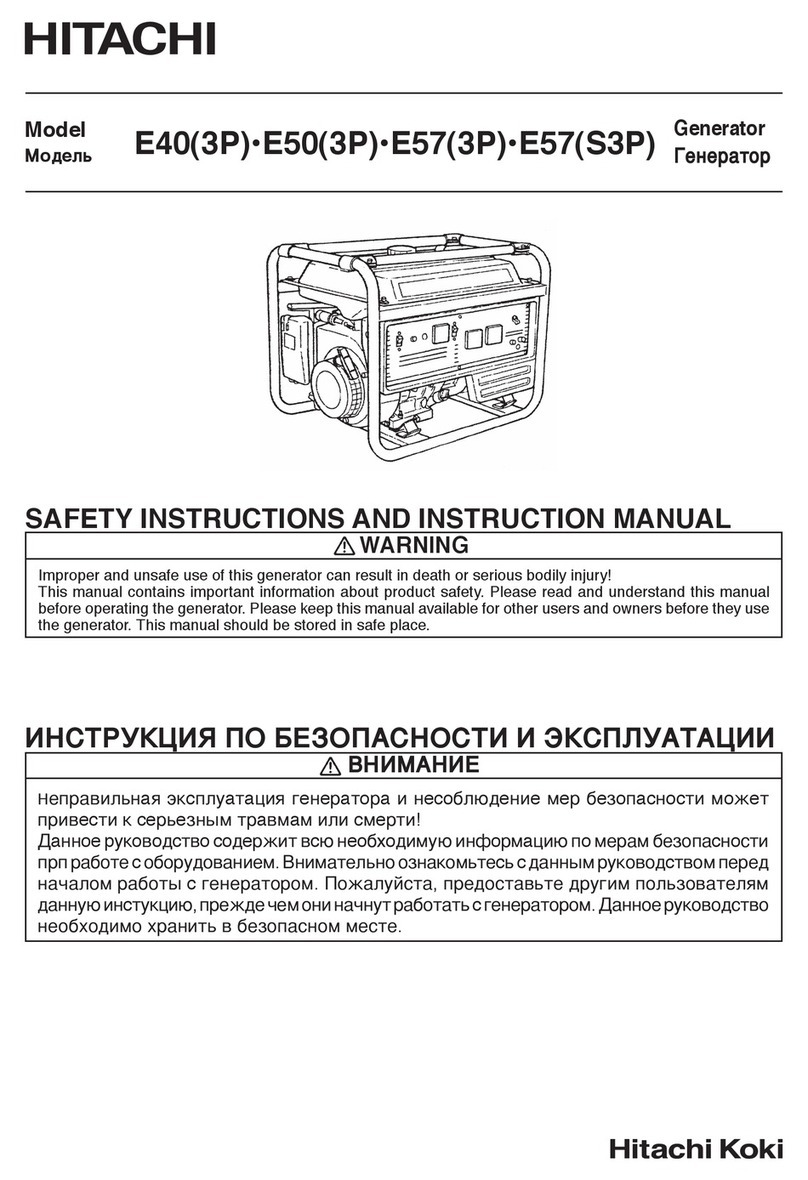
Hitachi
Hitachi E40 Safety instructions and instruction manual
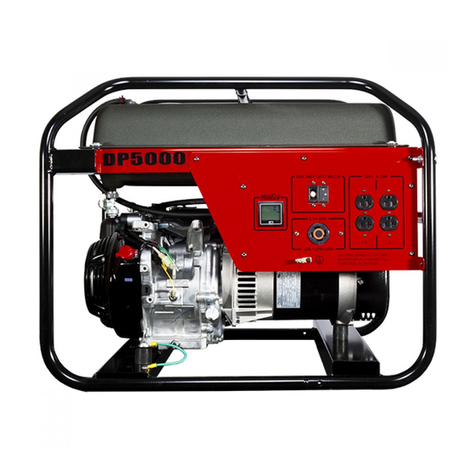
Winco
Winco DP5000/T Installation and operator's manual
